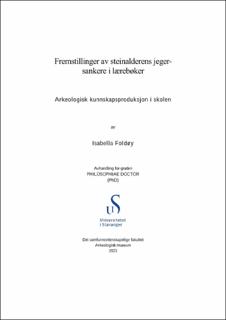| dc.contributor.advisor | Nyland, Astrid | |
| dc.contributor.advisor | Oma, Kristin Armstrong | |
| dc.contributor.advisor | Knutsen, Ketil | |
| dc.contributor.author | Foldøy, Isabella | |
| dc.date.accessioned | 2023-06-06T10:05:18Z | |
| dc.date.available | 2023-06-06T10:05:18Z | |
| dc.date.issued | 2023 | |
| dc.identifier.citation | Fremstillinger av steinalderens jeger-sankere i lærebøker : Arkeologisk kunnskapsproduksjon i skolen av Isabella Foldøy, Stavanger : University of Stavanger, 2023 (PhD thesis UiS, no. 703) | en_US |
| dc.identifier.isbn | 978-82-8439-168-7 | |
| dc.identifier.issn | 1890-1387 | |
| dc.identifier.uri | https://hdl.handle.net/11250/3070097 | |
| dc.description.abstract | Avhandlingen handler om arkeologisk kunnskapsproduksjon i skolen. Studien består av 23 lærebøker tilknyttet læreplanene L97 og K06. Jeg undersøker hvordan representasjoner av og fortellinger om steinalderens jeger-sankere bidrar til å forme forståelser om dem. Jeg utforsker hva representasjonene og fortellingene formidler, og hvorvidt det samsvarer med læreplanmål fra L97 og K06 om toleranse og likestilling. Bøkene undersøkes gjennom en kvantitativ analyse av ikonografi og en kvalitativ analyse av fortellinger. Resultatene fra analysene diskuteres i lys av noen sentrale begreper fra postkolonial teori og feministisk kritikk.
Kort sagt finner jeg at det brukes en representasjonstradisjon for steinalderens jeger-sankere som reproduserer problematiske fremstillinger og skaper annengjøring. Det brukes eksemplariske fortellinger som fremstiller jeger-sankere som en primitiv kontrast til mennesker i moderne samfunn. Disse resultatene diskuteres gjennom konsepter som dehumanisering, essensialisme, stereotypier og fixity. Undersøkelsene viser at også kvinner og jenter er underrepresenterte, og at representasjonene fremstilles en arbeidsfordeling der menn har aktive roller, mens kvinner er mer passive. De tradisjonelle fortellingene fremstiller jeger-sankere som noe opphavelig, statisk og som et samfunn med tradisjonelle kjønnsnormer. Disse kjønnede fremstillingene diskuteres i lys av performativitet, fortellingspraksiser og situert kunnskap. Jeg mener derfor at lærebøkene ikke oppfyller læreplanmålene fra L97 og K06, men i stedet reproduserer ideer situert i 1800-tallets kjønnsnormer og vitenskapelige diskurs, som var farget av raseteori og eurosentrisme. Jeg argumenterer for å opprette arkeologididaktikk som et eget forskningsfelt for å fange opp og endre problematiske fremstillinger av fortiden. | en_US |
| dc.description.abstract | My PhD research explores archaeological knowledge production through representations and narratives of Stone Age hunter-gatherers in Norwegian school textbooks. In the thesis, I examine 23 textbooks, all founded on guidelines from the national curriculum “L97” and “K06”. I interpret what the representations and narratives in the textbooks convey, and whether they achieve the educational objectives from the national curriculum regarding tolerance of other cultures and gender equality. The books are examined through a quantitative analysis of iconography and a qualitative analysis of the narratives. The discussion of the results is interpreted within the perspectives of postcolonial critique and feminist theory.
My analysis shows that Stone Age hunter-gatherers are portrayed with a specific iconography, and that the representations promote othering. I argue that the same can be said for the use of exemplary narratives that describe hunter-gatherers as being separate from or in juxtaposition to modern society. I problematise othering through using the concepts of stereotypes, dehumanisation, essentialism and fixity. The representations are also gendered, and women and girls are underrepresented. The textbooks use a clear division of labour where men have active roles, while women have more passive roles. The traditional narratives view hunter-gatherer societies as static and hunter-gatherers are portrayed as having a “natural” way of life, with strict traditional gender norms. The gendered representations are discussed using the concepts of performativity, storytelling practices and situated knowledge. I also argue that the Stone Age representations do not accomplish the educational objectives from the national curricula. Instead, they reproduce ideas from older research that were situated in the gender norms and scientific discourse of the 1800s, influenced by racial theory and eurocentrism. I also argue that it is necessary to develop archaeological didactics as a field of research, to address and update representations of the past. | en_US |
| dc.language.iso | nob | en_US |
| dc.publisher | Stavanger : University of Stavanger | en_US |
| dc.relation.ispartofseries | PhD Theses;703 | |
| dc.rights | Navngivelse 4.0 Internasjonal | * |
| dc.rights.uri | http://creativecommons.org/licenses/by/4.0/deed.no | * |
| dc.subject | arkeologi | en_US |
| dc.subject | didaktikk | en_US |
| dc.subject | archaeology | en_US |
| dc.subject | jeger-sankere | en_US |
| dc.subject | hunter-gatherers | en_US |
| dc.title | Fremstillinger av steinalderens jeger-sankere i lærebøker : Arkeologisk kunnskapsproduksjon i skolen | en_US |
| dc.type | Doctoral thesis | en_US |
| dc.rights.holder | © 2023 Isabella Foldøy | en_US |
| dc.subject.nsi | VDP::Humaniora: 000::Arkeologi: 090 | en_US |

